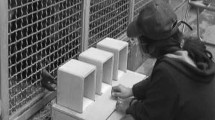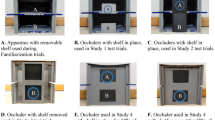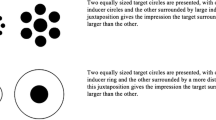Abstract
Recently, (Collier-Baker E, Davis JM, Suddendorf T (2004) J Comp Psychol 118:421–433) suggested that domestic dogs do not understand invisible displacements. In the present study, we further investigated the hypothesis that the search behavior of domestic dogs in invisible displacements is guided by various visual cues inherent to the task rather than by mental representation of an object’s past trajectory. Specifically, we examined the role of the experimenter as a function of the final position of the displacement device in the search behavior of domestic dogs. Visible and invisible displacement problems were administered to dogs (N = 11) under two conditions. In the Visible-experimenter condition, the experimenter was visible whereas in the Concealed-experimenter condition, the experimenter was visibly occluded behind a large rigid barrier. Our data supported the conclusion that dogs do not understand invisible displacements but primarily search as a function of the final position of the displacement device and, to a lesser extent, the position of the experimenter.




Similar content being viewed by others
References
Agnetta B, Hare B, Tomasello M (2000) Cues to food location that domestic dogs (Canis familiaris) of different ages do and do not use. Anim Cogn 3:107–112
American Kennel Club (1992) The complete dog book, 18th edn. Howell Book, New York
Barth J, Call J (2006) Tracking the displacement of objects: a series of tasks with great apes (Pan troglodytes, Pan paniscus, Gorilla gorilla, and Pongo pygmaeus) and young children (Homo sapiens). J Exp Psychol Anim Behav Process 32:239–252
Bräuer J, Kaminski J, Riedel J, Call J, Tomasello M (2006) Making inferences about the location of hidden food: social dog, causal ape. J Comp Psychol 120:38–47
Call J (2001) Object permanence in orangutans (Pongo pygmaeus), chimpanzees (Pan troglodytes), and children (Homo sapiens). J Comp Psychol 115:159–171
Collier-Baker E, Suddendorf T (2006) Do chimpanzees (Pan troglodytes) and 2-year-old children (Homo sapiens) understand double invisible displacement? J Comp Psychol 120:89–97
Collier-Baker E, Davis JM, Suddendorf T (2004) Do dogs (Canis familiaris) understand invisible displacement? J Comp Psychol 118:421–433
Collier-Baker E, Davis JM, Nielsen M, Suddendorf T (2006) Do chimpanzees (Pan troglodytes) understand single invisible displacement? Anim Cogn 9:55–61
De Blois ST, Novak MA (1994) Object permanence in Rhesus Monkeys (Macaca mulatta). J Comp Psychol 108:318–327
De Blois ST, Novak MA, Bond M (1998) Object permanence in Orangutans (Pongo pygmaeus) and squirrel monkeys (Saimiri sciurus). J Comp Psychol 112:137–152
Doré FY (1986) Object permanence in adult cats (Felis catus). J Comp Psychol 100:340–347
Doré FY, Dumas C (1987) Psychology of animal cognition: Piagetian studies. Psychol Bull 102:219–233
Doré FY, Fiset S, Goulet S, Dumas M-C, Gagnon S (1996) Search behavior in cats and dogs: interspecific differences in working memory and spatial cognition. Anim Learn Behav 24:142–149
Dumas C, Doré FY (1989) Cognitive development of kittens: a cross-sectional study of object permanence. J Comp Psychol 103:191–200
Dumas C, Doré FY (1991) Cognitive development in kittens (Felis catus): an observational study of object permanence and sensorimotor intelligence. J Comp Psychol 105:357–365
Fiset S, Perreault M (2004) Vertical invisible displacements in domestic dogs: gravity or linearity bias? Unpublished data, Université de Moncton, Moncton, New Brunswick, Canada
Fiset S, Gagnon S, Beaulieu C (2000) Spatial encoding of hidden objects in dogs (Canis familiaris). J Comp Psychol 114:315–324
Fiset S, Landry F, Ouellette M (2006) Egocentric search for disappearing objects in domestic dogs: evidence for a geometric hypothesis of direction. Anim Cogn 9:1–12
Funk MS (1996) Development of object permanence in the New Zealand parakeet (Cyanoramphus auriceps). Anim Learn Behav 24:375–383
Gagnon S, Doré FY (1992) Search Behavior in various breeds of adult dogs (Canis familiaris): object permanence and olfactory cues. J Comp Psychol 106:58–68
Gagnon S, Doré FY (1993) Search behavior of dogs (Canis familiaris) in invisible displacement problems. Anim Learn Behav 21:246–254
Gagnon S, Doré FY (1994) Cross-sectional study of object permanence in domestic puppies (Canis familiaris). J Comp Psychol 108:220–232
Gruber HE, Girgus JS, Banuazizi A (1971) The development of object permanence in the cat. Dev Psychol 4:9–15
Hare B, Tomasello M (1999) Domestic dogs (Canis familiaris) use human and conspecific social cues to locate hidden food. J Comp Psychol 113:173–177
Hare B, Brown M, Williamson C, Tomasello M (2002) The domestication of social cognition in dogs. Science 298:1634–1636
Howell CH (1987) Statistical methods for psychology, 2nd edn. Duxbury, Boston
Mathieu M, Bouchard MA, Granger L, Herscovitch J (1976) Piagetian object permanence in Cebus capucinus, Lagothrica flavicauda and Pan troglodytes. Anim Behav 24:585–588
McKinley J, Sambrook TD (2000) Use of human-given cues by domestic dogs (Canis familiaris) and horses (Equus caballus). Anim Cogn 3:13–22
Mendes N, Huber L (2004) Object permanence in common marmosets (Callithrix jacchus). J Comp Psychol 118:103–112
Miklósi Á, Polgardi R, Topál J, Csányi V (1998) Use of experimenter-given cues in dogs. Anim Cogn 1:113–121
Miklósi Á, Kubinyi E, Topál J, Gácsi M, Virányi Z, Csányi V (2003) A simple reason for a big difference: wolves do not look back at humans but dogs do. Curr Biol 13:763–766
Natale F, Antinucci F, Spinozzi G, Poti P (1986) Stage 6 object concept in nonhuman primate cognition: a comparison between gorilla (Gorilla gorilla gorilla) and Japanese macaque (Macaca fuscata). J Comp Psychol 100:335–339
Neiworth JJ, Steinmark E, Basile BM, Wonders R, Steely F, DeHart C (2003) A test of object permanence in a new-world mondey species, cotton top tamarins (Saguinus oedipus). Anim Cogn 6:27–37
Osthaus B, Slater AM, Lea SEG (2003) Can dogs defy gravity? A comparison with the human infant and a non-human primate. Dev Sci 6:489–497
Parker ST (1977) Piaget’s sensorimotor series in an infant macaque: a model for comparative unstereotyped behavior and intelligence in human and nonhuman primates. In: Chevalier-Skolnikoff S, Poirier FE (eds) Primate bio-social development: biological, social, and ecological determinants. Garland, New York, pp 43–112
Pasnak R, Kurkjian M, Triana E (1988) Assessment of stage 6 object permanence. Bull Psychol Soc 26:368–370
Pepperberg IM (2002) The value of the Piagetian framework for comparative cognitive studies. Anim Cogn 5:177–182
Pepperberg IM, Funk MS (1990) Object permanence in four species of psittacine birds: an African grey parrot (Psittacus erithacus), an Illiger mini macaw (Ara Maracana), a parakeet (Melopsittacus undulatus), and a cockatiel (Nymphicus hollandicus). Anim Learn Behav 18:97–108
Pepperberg IM, Kozak FA (1986) Object permanence in the African gray parrot (Psittacus erithacus). Anim Learn Behav 14:322–330
Pepperberg IM, Willner MR, Gravitz LB (1997) Development of Piagetian object permanence in a grey parrot (Psittacus erithacus). J Comp Psychol 111:63–75
Piaget J (1937) La construction du réel chez l’enfant. Delachaux and Niestlé, Neuchâtel, Paris, France
Pollok B, Prior H, Gunturkun O (2000) Development of object permanence in food-storing magpies (Pica pica). J Comp Psychol 114:148–157
Redshaw M (1978) Cognitive development in human and gorilla infants. J Hum Evol 7:133–141
Riedel J, Buttelmann D, Call J, Tomasello M (2006) Domestic dogs (Canis familiaris) use a physical marker to locate hidden food. Anim Cogn 9:27–35
Spinozzi G, Potí P (1993) Piagetian Stage 5 in two infant chimpanzees (Pan troglodytes): the development of permanence of objects and the spatialization of causality. Int J Primatol 14:905–917
Suddendorf T, Whiten A (2001) Mental evolution and development: evidence for secondary representation in children, great apes and other animals. Psychol Bull 127:629–650
Thinus-Blanc C, Poucet B, Chapuis N (1982) Object permanence in cat : analysis in locomotor space. Behav Process 7:81–87
Triana E, Pasnak R (1981) Object permanence in cats and dogs. Anim Learn Behav 9:135–139
Vilá C, Savolainen C, Maldonado JE, Amorim IR, Rice JE, Honeycutt RL, Crandall KA, Lundeberg J, Wayne RK (1997) Multiple and ancient origins of the domestic dog. Science 276:1687–1689
Wood S, Moriarty KM, Gardner BT, Gardner RA (1980) Object permanence in child and chimpanzee. Anim Learn Behav 8:3–9
Acknowledgements
This research was supported by an operating research grant from the Natural Sciences and Engineering Research Council of Canada (NSERC) and by a research grant from the Faculté des Études Supérieures et de la Recherche (FESR) of Université de Moncton. Valérie LeBlanc was supported by an Undergraduate Student Research Award from NSERC. The experiments received approval from the Comité de protection des animaux from the Faculté des études supérieures et de la recherche de l’Université de Moncton, which is responsible for the application and enforcement of rules of the Canadian Council on Animal Care. We thank the owners of the dogs who participated in these experiments.
Author information
Authors and Affiliations
Corresponding author
Rights and permissions
About this article
Cite this article
Fiset, S., LeBlanc, V. Invisible displacement understanding in domestic dogs (Canis familiaris): the role of visual cues in search behavior. Anim Cogn 10, 211–224 (2007). https://doi.org/10.1007/s10071-006-0060-5
Received:
Revised:
Accepted:
Published:
Issue Date:
DOI: https://doi.org/10.1007/s10071-006-0060-5




